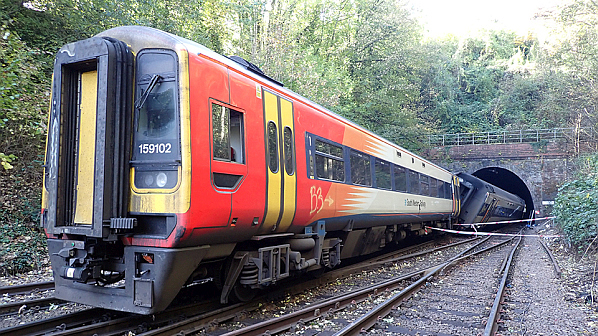AN interim report published by Britain’s Rail Accident Investigation Branch (RAIB) into a collision at Salisbury on October 31 2021 found evidence of railhead contamination at 12 sample locations in the 3.2km of railway leading up to the location where the trains collided.
At around 18.45, South Western Railway (SWR) passenger service 1L53 from London Waterloo to Honiton collided with the side of Great Western Railway (GWR) passenger service 1F30 operating from Portsmouth Harbour to Bristol Temple Meads. The collision occurred at Salisbury Tunnel Junction, on the immediate approach to Fisherton Tunnel.
The front two coaches of the SWR train and the rear two coaches of the GWR train derailed. Both trains continued into the tunnel following the collision before they came to a stop. 13 passengers and a member of railway staff required treatment in hospital as a result of the accident.
RAIB found that many areas had a medium or heavy level of contamination, and that the thickness of the leaf deposit was relatively consistent through each of the areas surveyed. RAIB said it was likely that the rails were wet at the time of the accident.
RAIB also found that the railhead treatment train (RHTT), which conducts high-pressure water jetting, and which may also apply an adhesion modifier gel to the rails, was due to pass the site at 17.03 but had been rescheduled to around 23.00 because of planned infrastructure work between Southampton and Brockenhurst. This meant there would have been an interval of 32 hours between the RHTT operating through the area, with the last RHTT train passing the junction at 11.06 on October 30.
RAIB will continue its investigation and says its objectives for the investigation are to:
- continue to identify the sequence of events
- continue to establish, as far as practical, the level of wheel/rail adhesion present on the down main line on the approach to the junction
- establish the status and performance of the braking, wheel slip/slide protection and sanding systems on the SWR train
- consider the behaviour of both trains during and following the collision and the damage caused to both
- consider the actions taken on the day of the accident to manage the risk of low adhesion given the time of year and prevailing weather conditions
- consider the actions of the SWR driver and any factors which may have influenced them
- consider SWR’s policies and processes relating to low wheel/rail adhesion and how it managed the risk of low adhesion in the Salisbury area including: risk assessment and management systems, collation, analysis and dissemination of data, railhead treatment, monitoring of railhead conditions and information disseminated to operators, regulation of trains at high-risk locations and the management of vegetation
- identify any relevant underlying factors, including any actions taken in response to previous safety recommendations and research conducted related to managing the risks of low adhesion, and
- make recommendations, as appropriate, to prevent a recurrence.
An article by the RSSB explaining how research into low rail adhesion during autumn is leading to new approaches to solving the problem was published in the February edition of IRJ. Digital subscribers can read it here.

